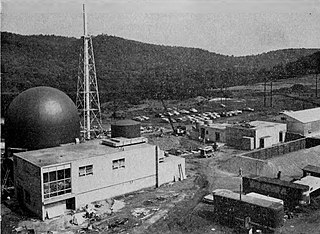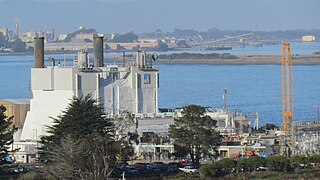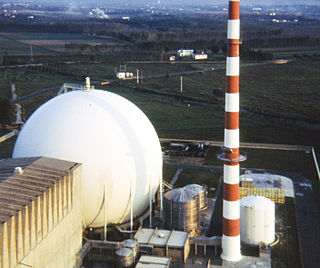Related Research Articles

Brownfield is land that is abandoned or underutilized due to pollution from industrial use. The specific definition of brownfield land varies and is decided by policy makers and/or land developers within different countries. The main difference in definitions of whether a piece of land is considered a brownfield or not depends on the presence or absence of pollution. Overall, brownfield land is a site previously developed for industrial or commercial purposes and thus requires further development before reuse.
The S1C reactor was a prototype naval reactor designed for the United States Navy to provide electricity generation and propulsion on warships. The S1C designation stands for:

Land rehabilitation as a part of environmental remediation is the process of returning the land in a given area to some degree of its former state, after some process has resulted in its damage. Many projects and developments will result in the land becoming degraded, for example mining, farming and forestry. It is crucial that governments and businesses act proactively by working on improvement, lay out rehabilitation standards and ensure that decisions on mediation should be based around value judgment for higher sustainability in the future.

Environmental technology (envirotech) is the use of engineering and technological approaches to understand and address issues that affect the environment with the aim of fostering environmental improvement. It involves the application of science and technology in the process of addressing environmental challenges through environmental conservation and the mitigation of human impact to the environment.

Pilgrim Nuclear Power Station (PNPS) is a closed nuclear power plant in Massachusetts in the Manomet section of Plymouth on Cape Cod Bay, south of the tip of Rocky Point and north of Priscilla Beach. Like many similar plants, it was constructed by Bechtel, and was powered by a General Electric BWR 3 boiling water reactor inside of a Mark 1 pressure suppression type containment and generator. With a 690 MWe production capacity, it produced about 14% of the electricity generated in Massachusetts.

Surface mining, including strip mining, open-pit mining and mountaintop removal mining, is a broad category of mining in which soil and rock overlying the mineral deposit are removed, in contrast to underground mining, in which the overlying rock is left in place, and the mineral is removed through shafts or tunnels.

The Shippingport Atomic Power Station was the world's first full-scale atomic electric power plant devoted exclusively to peacetime uses. It was located near the present-day Beaver Valley Nuclear Generating Station on the Ohio River in Beaver County, Pennsylvania, United States, about 25 miles (40 km) from Pittsburgh.

The Santa Susana Field Laboratory (SSFL), formerly known as Rocketdyne, is a complex of industrial research and development facilities located on a 2,668-acre (1,080 ha) portion of Southern California in an unincorporated area of Ventura County in the Simi Hills between Simi Valley and Los Angeles. The site is located approximately 18 miles (29 km) northwest of Hollywood and approximately 30 miles (48 km) northwest of Downtown Los Angeles. Sage Ranch Park is adjacent on part of the northern boundary and the community of Bell Canyon is along the entire southern boundary.

The Rancho Seco Nuclear Generating Station is a decommissioned nuclear power plant built by the Sacramento Municipal Utility District (SMUD) in Herald, California.

The Saxton Nuclear Experiment Station, also known as the Saxton Nuclear Generating Station or Saxton Nuclear Experimental Corporation Facility, was a small nuclear power plant located in Bedford County, near Saxton, Pennsylvania.

Big Rock Point was a nuclear power plant near Charlevoix, Michigan, United States. Big Rock operated from 1962 to 1997. It was owned and operated by Consumers Power, now known as Consumers Energy. Its boiling water reactor was made by General Electric (GE) and was capable of producing 67 megawatts of electricity. Bechtel Corporation was the primary contractor.
Nuclear decommissioning is the process leading to the irreversible complete or partial closure of a nuclear facility, usually a nuclear reactor, with the ultimate aim at termination of the operating licence. The process usually runs according to a decommissioning plan, including the whole or partial dismantling and decontamination of the facility, ideally resulting in restoration of the environment up to greenfield status. The decommissioning plan is fulfilled when the approved end state of the facility has been reached.

Portsmouth Gaseous Diffusion Plant is a facility located in Scioto Township, Pike County, Ohio, just south of Piketon, Ohio, that previously produced enriched uranium, including highly enriched weapons-grade uranium, for the United States Atomic Energy Commission (AEC), the U.S. nuclear weapons program and Navy nuclear propulsion; in later years, it produced low-enriched uranium for fuel for commercial nuclear power reactors. The site never hosted an operating nuclear reactor.

The Humboldt Bay Power Plant, Unit 3 was a 63 MWe nuclear boiling water reactor, owned by Pacific Gas and Electric Company that operated from August 1963 to July 1976 just south of Eureka, California.
Nuclear entombment is a method of nuclear decommissioning in which radioactive contaminants are encased in a structurally long-lived material, such as concrete. This prevents radioactive material and other contaminated substances from being exposed to human activity and the environment. Entombment is usually applied to nuclear reactors, but also some nuclear test sites. Nuclear entombment is the least used of three methods for decommissioning nuclear power plants, the others being dismantling and deferred dismantling. The use of nuclear entombment is more practical for larger nuclear power plants that are in need of both long and short term burials, as well as for power plants which seek to terminate their facility licenses. Entombment is used on a case-by-case basis because of its major commitment with years of surveillance and complexity until the radioactivity is no longer a major concern, permitting decommissioning and ultimate unrestricted release of the property. Considerations such as financial backing and the availability of technical know-how are also major factors.

Garigliano Nuclear Power Plant was a nuclear power plant located at Sessa Aurunca (Campania), in southern Italy. It was named after the river Garigliano.

Land recycling is the reuse of abandoned, vacant, or underused properties for redevelopment or repurposing.
SAFSTOR is a nuclear decommissioning method in which a nuclear power plant or facility governed by the United States Nuclear Regulatory Commission, is "placed and maintained in a condition that allows the facility to be safely stored and subsequently decontaminated to levels that permit release for unrestricted use".
Water in Arkansas is an important issue encompassing the conservation, protection, management, distribution and use of the water resource in the state. Arkansas contains a mixture of groundwater and surface water, with a variety of state and federal agencies responsible for the regulation of the water resource. In accordance with agency rules, state, and federal law, the state's water treatment facilities utilize engineering, chemistry, science and technology to treat raw water from the environment to potable water standards and distribute it through water mains to homes, farms, business and industrial customers. Following use, wastewater is collected in collection and conveyance systems, decentralized sewer systems or septic tanks and treated in accordance with regulations at publicly owned treatment works (POTWs) before being discharged to the environment.

SOGIN is an Italian state-owned enterprise responsible for nuclear decommissioning as well as management and disposal of radioactive waste produced by industrial, research and medical processes. Founded in 1999 following the 1987 Italian referendums on nuclear power, SOGIN was originally part of state owned ENEL but became independent, but still government owned, in 2000. The company initially took over the Caorso, Enrico Fermi, Garigliano and Latina nuclear power plants, later adding other sites including ENEA's EUREX. The company has commenced the decommissioning of all the plants and is predicted to complete the work in 2036. The company has been involved in environmental remediation, radioactive waste management and nuclear safety work in Armenia, Bulgaria, China, Czech Republic, France, Kazakhstan, Lithuania, Romania, Russia, Slovakia and the Ukraine. SOGIN also undertakes other decontamination work and in 2005 started to help to decommission nuclear submarines of the Russian Navy.
References
- ↑ "NDA Environmental Report for Consultation 2005: "...there was an expectation that most sites would be restored for unrestricted re-use (i.e. to 'green field status')."". Archived from the original on 2014-10-06. Retrieved 2014-10-06.